

We may earn revenue from the products available on this page and participate in affiliate programs. Learn more ›
The brakes are just about the most important component of your car, next to the wheels and tires. You can lose an engine, transmission, or most of the windows while driving, and the car will still be relatively safe. Without brakes, though, you’re headed for trouble. Keeping them maintained and functioning properly is key to the safety of you and your passengers.
In saying this, it’s important to know just how long you can expect your brakes to last. Regular checks and replacement of key components at regular intervals is the primary way you can ensure your brakes will function properly when you need them most.
When thinking about brake life, it’s important to look at individual components separately. For disc brakes, you’ll want to look at your brake rotors and brake pads, while for drum brakes, you’ll be looking at the shoes and the drums themselves. Brake fluid is common to both systems and should be changed every two to three years during regular services.
Brake rotors are the actual discs that spin with the wheels. They are squeezed by the brake pads, with the resulting friction slowing down the vehicle. The lifespan of brake rotors depends on your driving habits, road conditions, and rotor quality. On average, brake rotors typically last between 50,000 to 70,000 miles.
Regular inspections and measurements of rotor thickness during routine maintenance can determine when they need replacement. Brake rotors are still often machined to gain more life out of a set, but that’s rarely cost-effective. If you get your rotors too hot, use them on track, or warp them, you might have to change them sooner.
Brake pads are the friction material that presses against the rotors to generate the stopping force. They generally have a shorter lifespan than rotors, on the order of 30,000 miles. However, they can wear faster with regular heavy braking, particularly if towing.
Conversely, EV owners will find regenerative braking means their brake pads are hardly used, and they can last significantly longer. When checking the pads at a regular service, if they’ve still got a healthy amount of material on them, and everything is moving smoothly, you’re good to go.
Drum brakes, commonly found in older vehicles and on the rear wheels of some modern cars, use brake shoes instead of pads. The lifespan of drum shoes is similar to brake pads at around 30,000 miles. The drums themselves can last up to 150,000 miles or more. However, periodic inspections are necessary to check for wear, contamination, or damage that may affect their performance.
It’s also important to consider the lifespan of other components, including brake lines, calipers, and master cylinders. These components generally have longer lifespans in the hundreds of thousands of miles. However, they can fail over time due to moisture, corrosion, wear, or damage. Regular brake system inspections by a qualified mechanic can identify potential issues and ensure your brakes are operating properly.
Understanding how long brakes and their various components last is crucial for maintaining a safe and reliable braking system. Regular inspections, routine maintenance, and careful driving habits can help prolong the lifespan of your brakes.
Always follow the manufacturer’s recommendations regarding brake maintenance intervals and hit up a mechanic if you notice issues like excessive squealing noises, longer stopping distances, vibrations, or a weird pedal feel. By regularly checking your brakes at each service, you can ensure the safety of yourself, your passengers, and others on the road for years to come. And you won’t hit a wall.